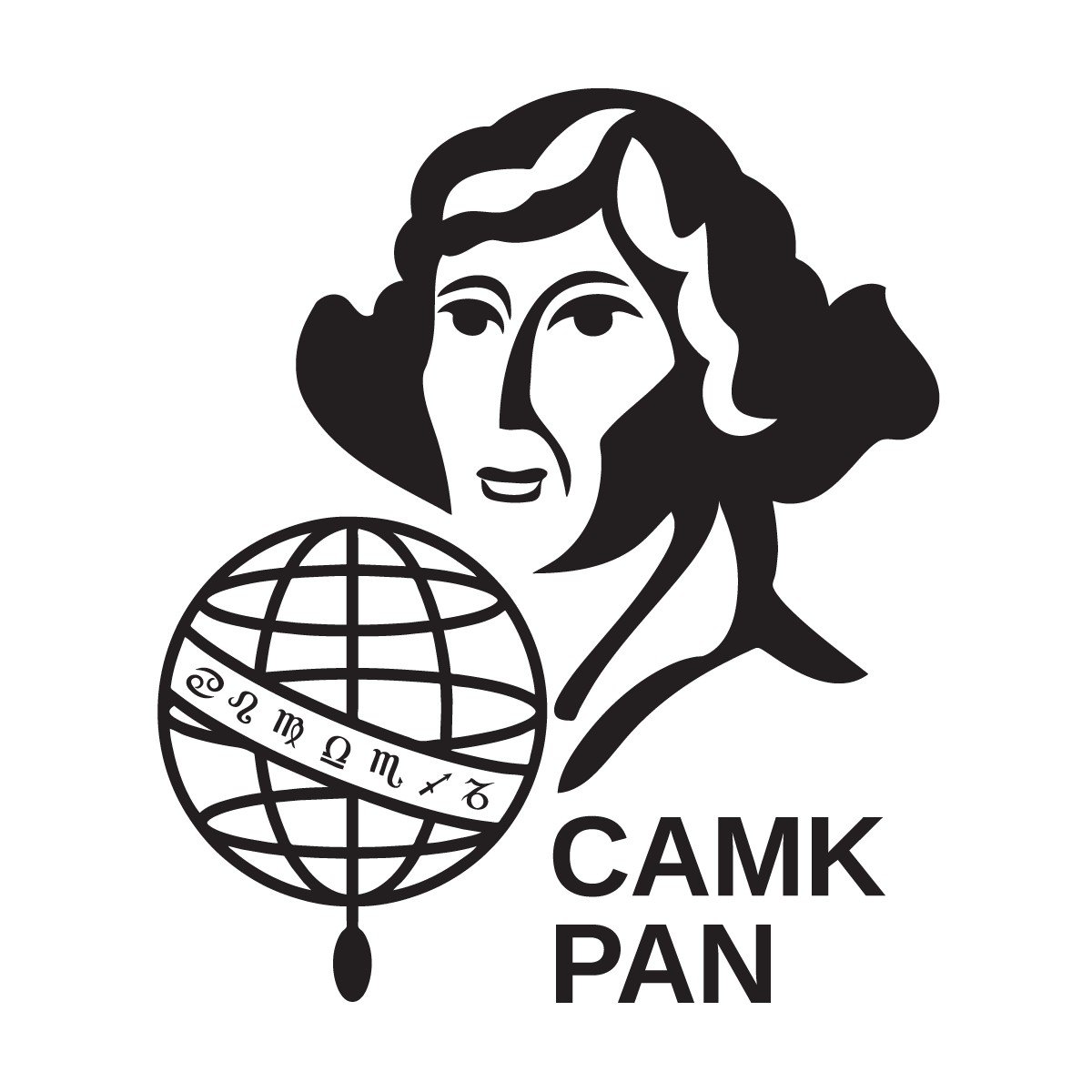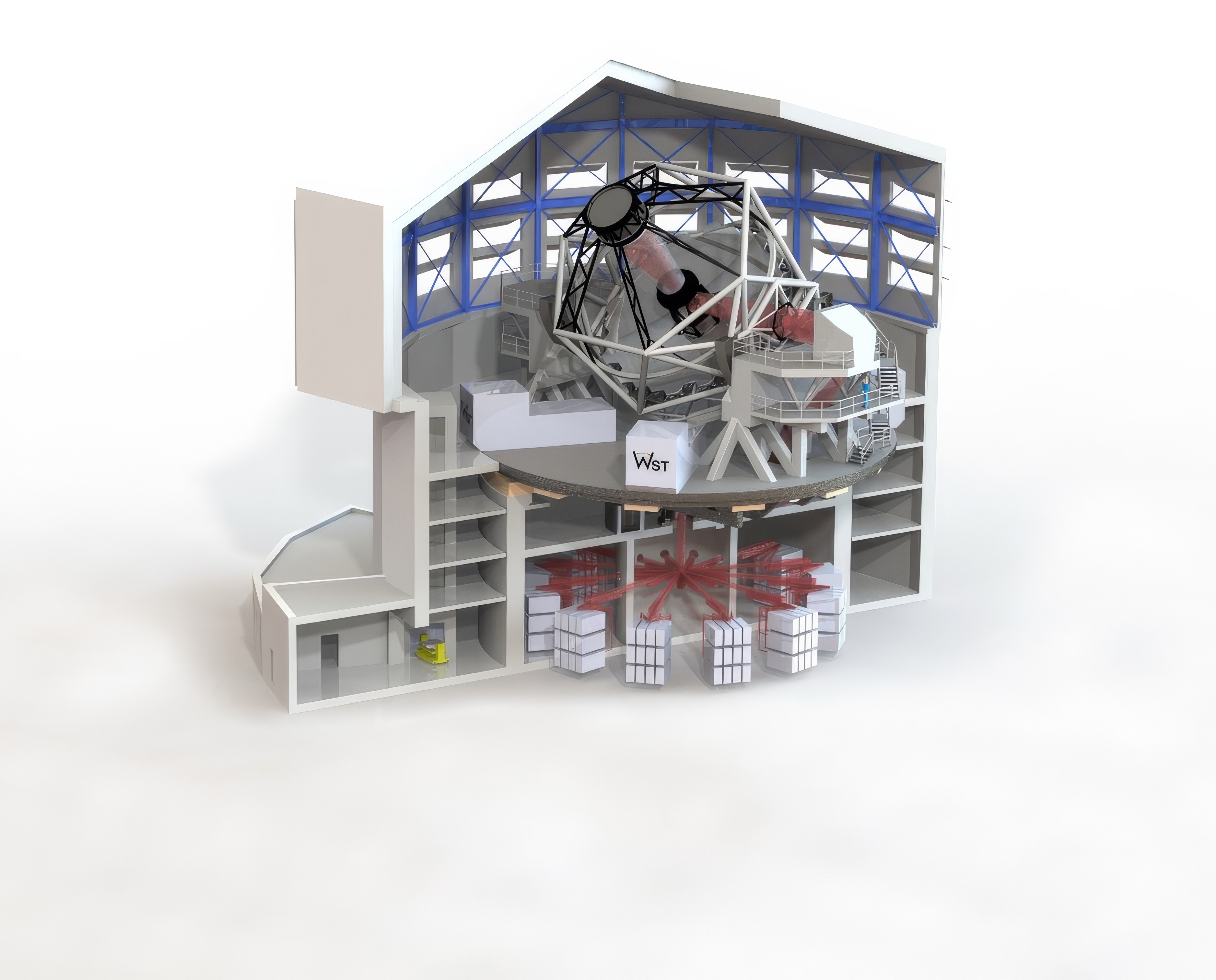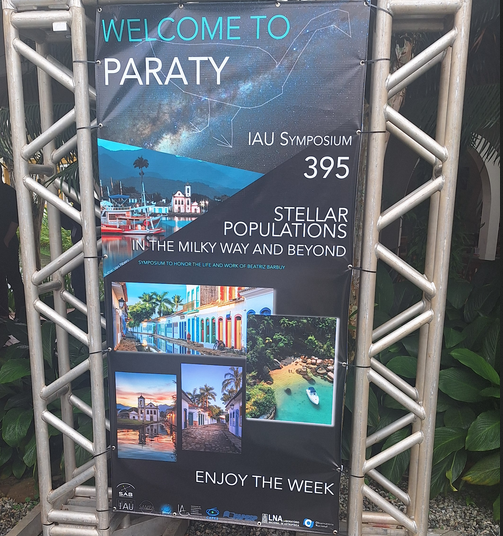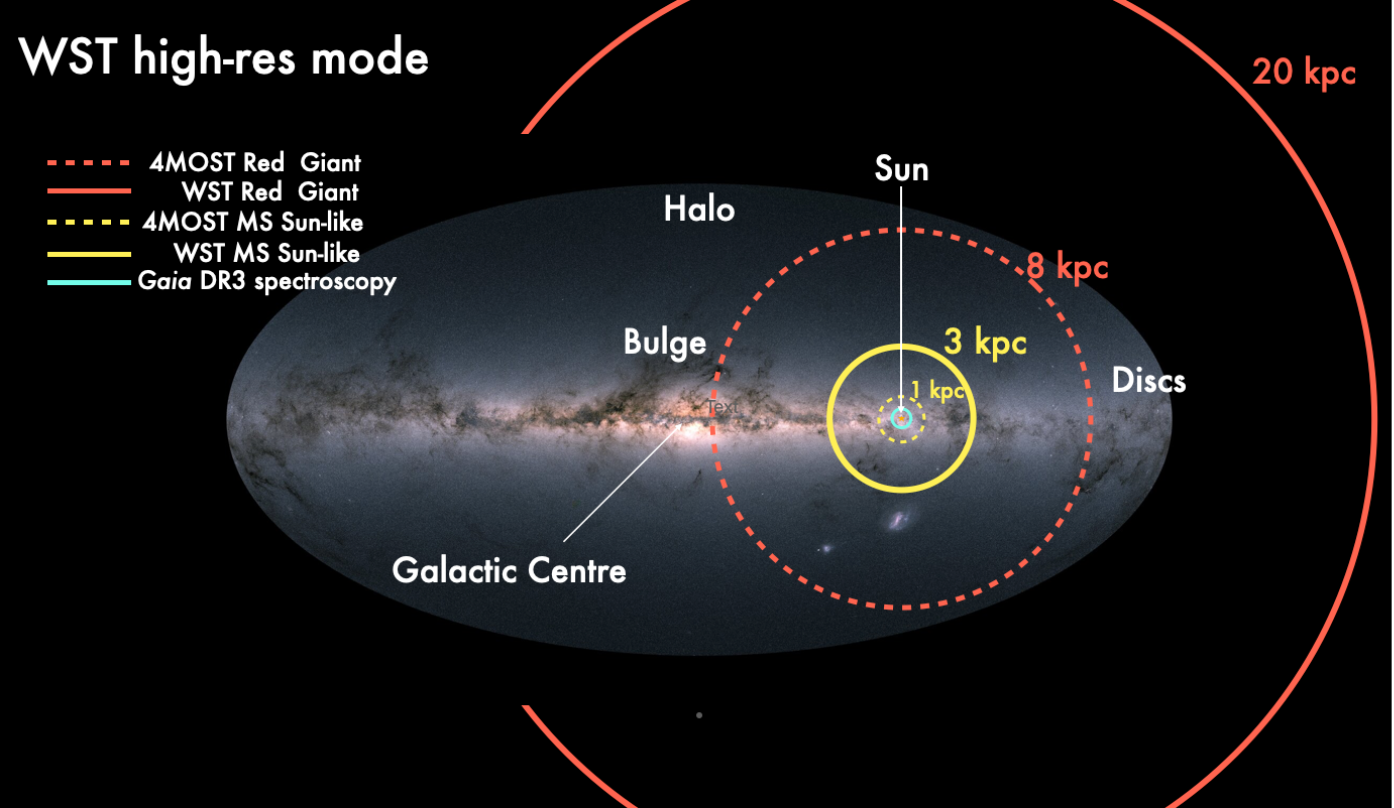Research news
SAGA Team at EAS 2025
A summary of the project "The history of C, N, and O in the Galaxy" was presented by S. Mikolaitis, of Vilnius University, during the symposium 8 entitled "Cosmic Chemical Enrichment: a tale of stars and a galaxies". The poster can be found here.
Results of the chemical abundance analysis of stars in several open clusters were presented by V. Bagdonas, Vilnius University, during the Symposium 9 entitled "Stellar Ages Across the Cosmos: Unveiling the Chronology of the Universe". The poster focus on the relations between abundance ratios such as [Y/Mg] and [C/N] with stellar ages. The poster can be found here.
The final contribution was presented by R. Smiljanic of the SAGA Team in Special Session 44 entitles "The HRMOS instrument: very high spectral resolution combined with multi-object capabilities". The poster entitled "Chemical evolution of carbon isotopic ratios with HRMOS" shows the results of simulations of 13CH features in main sequence stars of high metallicity. Measurements of 12C/13C in such stars can help to clarify the types of stars producing 13C in a Galactic scale. These measurements should be possible with data from an instrument like HRMOS. The poster can be found here.
First issue of the WST Chronicle
The Wide-Field Spectroscopic Telescope (WST) is a project to build a 12m telescope fully dedicated to multi-object spectroscopy. It will have a large field-of-view (> 3 sq deg) and combine in simultaneous operation high‐multiplex spectrographs of both low‐ and high‐resolution and a giant panoramic integral field spectrograph.
This first issue of the WST Chronicle is being published in June 2025. The aim is to publish it regularly to keep the whole scientific community updated about the progress in the project. The first issue includes descriptions of the WST consortium and its organisation, an overview of the science drivers and the top‐level requirements, and a presentation of the project timeline, among other information.
SAGA Team members are involved in the WST Science Team and R. Smiljanic is co-leading the working group responsible for the exoplanet, stellar, and Galactic science case. The WST project is funded by the European Union under Grant ID 101183153 awarded within the HORIZON-INFRA-2024-DEV-01 call.
In-person kick-off meeting of DAINA project
The project called "The history of C, N, and O in the Galaxy" is co-led by dr hab. Rodolfo Smiljanic from the Nicolaus Copernicus Astronomical Center, Polish Academy of Sciences, Poland and doc. dr Šarūnas Mikolaitis Institute of Theoretical Physics and Astronomy, Vilnius University, Lithuania.
The teams met for the in-person kick-off meeting in the Nicolaus Copernicus Astronomical Center, in Warsaw, Poland, between 27-29 May 2025. Together, the team reviewed the scientific goals of the project and planned the steps that will be needed to achieve those goals. Topics like data to be collected, data analysis methods, tools required for the project, research tasks of each team member, planned publications, and project outreach activities were discussed. In addition, some hands on work on the first sub-project of the collaboration was started. In this sub-project, we are reviewing the evolutionary status of two giants with peculiar lithium abundances in the old open cluster open cluster Trumpler 20. These are the only two giants, out of a sample of 40 similar stars, that show Li in their photospheres. Understanding their evolutionary history will help shed light into the extra-mixing processes suffered by low-mass stars.
Paper accepted in A&A!

In this paper, we analyse the connection between radial migration and Li depletion using a set of 1188 thin disc dwarf stars with a broad range of metallicities observed by the Gaia-ESO survey. In a previous work, their dynamical properties were studied and they were classified according to their migration properties, as having been churned outward or inward, or being blurred/undisturbed. We implement a parametric survival analysis using penalised splines (logistic distribution) to quantify how stellar properties (such as effective temperatures, masses, and ages) and motion (or migration) direction jointly influence Li depletion patterns.
Our results show that stars that were churned outward are predominantly Li-depleted, regardless of their metallicities. These stars are also the oldest, coldest, and least massive compared to those with similar metallicities that have either churned inward or kept their orbital radii. Our survival analysis confirms temperature as the primary driver of Li depletion, followed by metallicity and age, while migration direction shows negligible influence. The increasing proportion of outward-churned stars with higher metallicity (and older ages) indicates their dominant influence on the overall trend observed in the [Fe/H]-A(Li) space for stellar groups with [Fe/H] > 0. The survival model reinforces that the observed Li depletion stems primarily from intrinsic stellar properties (cool temperatures, higher metallicity, old ages) rather than migration history. This suggests the metallicity-dependent depletion pattern emerges through stellar evolution rather than Galactic dynamical processes.
The paper was lead by Maria Luiza L. Dantas, former postdoc at the SAGA Team and counted with the collaboration of R. Smiljanic, PI of the SAGA Team. The work was funded by Polish National Science Centre (NCN) through the project 2019/34/E/ST9/00133 entitled "Playing CHESS with stars: decoding the Galactic chemical enrichment history with stellar chemical abundances".
New team member!
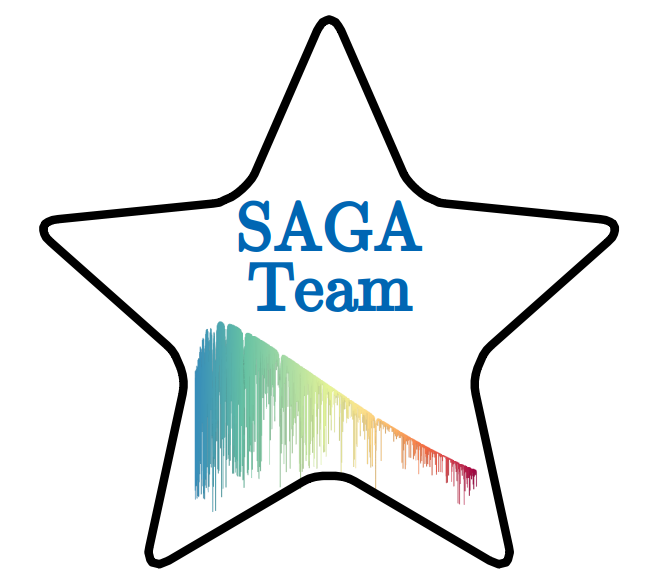 Dr. Arthur Alencastro Puls is a new post-doc joining the SAGA team to work on the OLD-MW project.
Dr. Arthur Alencastro Puls is a new post-doc joining the SAGA team to work on the OLD-MW project.
Arthur has a Ph.D. in astrophysics from the Australian National University, Canberra, Australia. Arthur has experience in studies of Galactic archaeology with his Ph.D. research combining high-resolution spectroscopy, asteroseismology from Kepler, and dynamics from Gaia. In his first post-doc at the Goethe University in Frankfurt, Germany, he studied heavy r-process elements in metal-poor stars. He is joining as a post-doc in the OLD-MW project. His work will concern developing a method that uses neural networks for the precise analysis of low-resolution spectra of metal-poor stars.
The OLD-MW project is co-funded by an OPUS-LAP/WEAVE grant of Polish National Science Centre (NCN) and the Deutsche Forschungsgemeinschaft through the project 2022/47/I/ST9/02358 entitled "The old Milky Way: a holistic approach for the accurate analysis of metal-poor stars".
New team member!
 Dr. Thibault Boulet is a new post-doc joining the SAGA team to work on the CHESS project.
Dr. Thibault Boulet is a new post-doc joining the SAGA team to work on the CHESS project.
Thibault has a Ph.D. in astrophysics from the University of Porto, Portugal, having worked at the Institute of Astrophysics and Space Sciences. Thibault has experience in studies of Galactic archaeology with his research combining spectroscopy, asteroseismology, astrometry, stellar modelling, and machine learning. In his Ph.D., he developed a stellar age dating technique, using machine learning algorithms and calibrated with asteroseismic data, to compute the age of stars in the Milky Way. He is joining as a post-doc in the CHESS project. His work will concern tests of chemical tagging using data from large stellar surveys.
The CHESS project is funded by Polish National Science Centre (NCN) through the project 2019/34/E/ST9/00133 entitled "Playing CHESS with stars: decoding the Galactic chemical enrichment history with stellar chemical abundances".
New paper accepted in A&A!

In this paper, we report the detailed chemical abundance patterns of two anomalous stars rich in r-process elements, originally identified among stars observed by the GALAH survey. We determine abundances for up to 47 chemical species (44 elements), of which 27 are neutron-capture elements. We find that one of the stars, BPS CS 29529-0089, is a proto-disk star of the Milky Way of r-II type. The second star, TYC 9219-2422-1, is part of the halo and associated with the Gaia-Sausage-Enceladus merger event.
BPS CS 29529-0089 is the most extreme example of r-process enhanced star known with disk-like kinematics and that is not carbon enhanced. TYC 9219-2422-1 is found to be an archetypal Gaia-Sausage-Enceladus star. Their abundances of C, Mg, Ni, Sc, Mn, and Al seem consistent with expectations for stars enriched by a single population III core collapse supernova, despite their relatively high metallicities ([Fe/H] ∼ −2.4).
The paper was lead by André Rodrigo da Silva, PhD student at the SAGA Team. The work was funded by Polish National Science Centre (NCN) through the project 2018/31/B/ST9/0146 entitled "Near-UV stellar spectroscopy: uncovering the past and building the future".
Paper accepted in A&A!

In this paper, we probe the orbital characteristics of a diverse set of stars in the thin disc observed by the Gaia-ESO survey. We aim to discern whether their orbits are predominantly influenced by churning or if they kept their orbital birth radii. We employ a Generalised Additive Model (GAM) to address the limitations inherent in radial metallicity gradients predicted by chemical evolution models, thereby facilitating the estimation of birth radii for the thin disc stars in our sample based on their ages and chemical composition.
Our results indicate that groups of stars with different chemical abundances exhibit distinct orbital behaviours. Metal-rich stars, formed in the inner regions of the Milky Way, seem to be predominantly churned outward. Their metal-poor counterparts, formed in the outer thin disc, exhibit the opposite behaviour. Additionally, we observe the potential effects of the pericentric passage of the Sagittarius dwarf galaxy in our most metal-poor subset of stars, formed in the outer disc. Finally, we estimate that the Sun’s most probable birth radius is 7.08 ± 0.24 kpc, with a 3σ range spanning from 6.46 to 7.81 kpc, in agreement with previous studies.
The paper was lead by Maria Luiza L. Dantas, former postdoc at the SAGA Team and counted with the collaboration of R. Smiljanic, PI of the SAGA Team. The work was funded by Polish National Science Centre (NCN) through the project 2019/34/E/ST9/00133 entitled "Playing CHESS with stars: decoding the Galactic chemical enrichment history with stellar chemical abundances".
WST Science Leaders Meeting
The innovative WST project aims to prepare a design for a 12-m telescope dedicated entirely to wide-field spectroscopic surveys in the optical band. The telescope will have three instruments. A low-resolution muti-object spectrograph (MOS) with 20000 fibers, a high-resolution MOS with 2000 fibers, and an integral field spectrograph of large field of view.
The meeting brought together the two PIs of the project, the project scientist, and leaders of all science working groups: i) Cosmology; ii) Extragalactic science; iii) Resolved stellar populations; iv) Galactic science, and v) Time domain. The science that WST can do in the 2040s was discussed, with particular emphasis on the transformative science cases that will be used to answer ESO's Expanding Horizon call, the procedure that will be used by ESO to select its next big facility. The results of the work in the science working groups will be made public in a new version of the WST Science White Paper before the end of the WST 3-year project.
SAGA Team members are involved in the WST Science Team and R. Smiljanic is co-leading the working group responsible for the exoplanet, stellar, and Galactic science case. The WST project is funded by the European Union under Grant ID 101183153 awarded within the HORIZON-INFRA-2024-DEV-01 call.
HRMOS Busy Week 2025
The High-Resolution Multi-Object Spectrograph (HRMOS) is a facility instrument that we plan to propose for the Very Large Telescope (VLT) of the European Southern Observatory (ESO). HRMOS will have high spectral resolution (R = 80000) combined with multi-object (50-80) capabilities and long term stability that will provide excellent radial velocity precision.
The meeting brought together the Science and Technical teams to discuss which instrument can address the majority of the science cases proposed for this instrument. The instrument will have three arms, with central wavelength dictated by the driving science cases (wavelength ranges to be decided). We will organize the publication of the v2 of the HRMOS white paper for after the EAS Meeting in Cork (end of June) where there will be a Special Session dedicated to HRMOS. In this way, we can collect any new ideas that may appear during the workshop;
SAGA Team members are involved in the HRMOS Science Team and R. Smiljanic is co-leading the working group responsible for the "Origin of the Elements and Nucleosynthesis" science cases.
CAMK Annual Meeting 2025
In this meeting, all scientists of the Institute present a short report about their activities in the previous year. Members of the SAGA Team summarized the activities of the Team in 4 presentations
The PhD student Sergen Özdemir presented preliminary results of an analysis of stars in a sample of globular clusters belonging to the Bulge. Using the CHESS pipeline and the differential analysis method, Sergen obtained atmospheric parameters for 7 stars.
The PhD student John Martínez Fernández presented preliminary results of a differential analysis of stars in a large set of 300 open clusters (almost 5000 spectra analysed). He used this large dataset to better understand the radial metallicity gradient of the Milky Way.
A new postdoc at the team, Deepak, introduced himself and talked about the motivation of his work on the topic of Galactic Archaeology. Deepak is developing the analysis method that will be used for the analysis of CUBES spectra of metal-poor stars.
Finally, R. Smiljanic, PI of the team, gave an update of progress in two large projects: i) CUBES, a new spectrograph being built for the VLT of ESO and ii) WST, a project to develop a new 12m telescope fully dedicated to multi-object spectroscopy. He also talked about the recent developments in the Gaia mission, which ended its almost 11 years of observations in January 15th.
DAINA project on CNO abundances starts!
The project called "The history of C, N, and O in the Galaxy" is co-led by dr hab. Rodolfo Smiljanic from the Nicolaus Copernicus Astronomical Center, Polish Academy of Sciences, Poland and doc. dr Šarūnas Mikolaitis Institute of Theoretical Physics and Astronomy, Vilnius University, Lithuania.
In this project, we will study the abundances of CNO in a large set of stars that belong to all stellar populations of the Milky Way. The project has two main goals: 1) to reconstruct the time scales of CNO production and identify the main types of stars that function as sources of these elements; 2) to better quantify the role of magnetic activity on the transport of chemical elements inside stars. Together, these efforts will help to clarify with unprecedented detail the intricacies of the history of C, N, and O in the Galaxy, providing important input to improve our understanding of Galactic and stellar evolution.
On the 15th of January, 2025, the Gaia satellite ended 10.5 years of scientific observations. However, the Gaia mission goes on.
This is, however, far from being the end of the Gaia mission! The Gaia team is working on preparing Gaia Data Release 4, which will make new groundbreaking science possible by including a much larger data volume than before. Gaia Data Release 4, covering 5.5 years of mission data, is expected in 2026. Furthermore, the final Gaia data release, Data Release 5, covering the full 10.5 years of mission data, is expected around the end of the decade.
R. Smiljanic, PI of the SAGA Team, is member of the Gaia Science Team.
One postdoctoral position is available to join the team and work on a comprehensive study of CNO abundances in Milky Way stars. Deadline is January 10th, 2025.
The overall project goal is to conduct a comprehensive analysis of the abundances of carbon, nitrogen, and oxygen in a large set of stars belonging to all main Galactic stellar populations. The results will be used to study the Galactic chemical enrichment in these elements as well as stellar mixing processes. The project aims to provide important new input to improve models of Galactic and stellar evolution.
The postdoc position in Warsaw will focus on studying the evolution of CNO abundances in the Milky Way, taking into account radial migration. Solid experience in some of the following topics would be assets: large spectroscopic surveys, machine learning, Galactic archaeology, or stellar spectroscopy.
Click here for more details on how to apply.
The European Union funds the conceptual study of the Wide Field Spectroscopic Telescope
The innovative WST project aims to build a telescope dedicated entirely to wide-field spectroscopic surveys in the optical band, covering all types of celestial objects—from distant galaxies to asteroids and comets within our Solar System.
The consortium includes 19 research institutions across Europe and Australia, with a science team of over six hundred members from 32 countries distributed in all five continents. The Nicolaus Copernicus Astronomical Center (NCAC) of the Polish Academy of Sciences is part of the WST consortium.
SAGA Team members are involved in the WST Science Team and R. Smiljanic is co-leading the working group responsible for the exoplanet, stellar, and Galactic science case. With the grant, the SAGA Team will be able to fund 18 months of a postdoc position. Together with the WST Science Team, we will help expand and consolidate the Galactic science case that will be addressed by WST.
Saga Team takes part at the IAU Symposium 395 in Paraty, Brazil
How galaxies form is one of the most fundamental questions in modern astrophysics. As the only galaxy for which kinematics and chemical compositions can be obtained for millions of resolved stars, the Milky Way can provide fundamental clues to this question. This symposium also served to honor the life and work of the Brazilian astrophysicist Beatriz Barbuy, who has made key contributions to the study of stellar populations in the Milky Way and beyond.
Two members of the SAGA Team participated in the symposium. The PhD student Sergen Özdemir presented results from his thesis work, related to the analysis of stars in globular clusters. The analysis is using the new CHESS pipeline, being developed in the team. The P.I. of the team, Rodolfo Smiljanic, presented the CHESS pipeline iself.
The project "Playing CHESS with stars" is funded by the National Science Center (2019/34/E/ST9/00133).
One postdoctoral position is available to join the team and work on a comprehensive spectroscopic study of metal-poor stars. Deadline is December 6th, 2024.
The overall project aim is to develop a holistic analysis methodology that can be applied to spectra of metal-poor stars obtained by different instruments and return results that are on a single, consistent scale. The results will be used for a meticulous study of the properties of the first nucleosynthesis sources of stellar origin in the Universe and to reconstruct the early chemical evolution of our Galaxy.
The position will focus on the analysis of low-resolution spectra and investigate machine learning methods that can be applied to the analysis of stellar spectra. This postdoc may also collaborate on work related to 4MOST. Solid experience in some of the following topics would be assets: machine learning applied to the analysis of stellar spectra, Galactic archaeology, stellar spectroscopy.
Click here for more details on how to apply.
New research grant awarded to the SAGA Team for a collaboration with Lithuanian researchers
This three-year project will be conducted in a collaboration with doc. dr Šarūnas Mikolaitis from the Institute of Theoretical Physics and Astronomy, Vilnius University, Lithuania. The aim of this project is to conduct a comprehensive, homogeneous, and precise analysis of the abundances of carbon, nitrogen, and oxygen (CNO) in a large set of stars belonging to all main Galactic stellar populations. We will use the results to investigate the chemical enrichment history of these elements and explore the effects of evolutionary mixing processes on their abundances in stellar atmospheres. We will announce a post-doc position to work with the team in Warsaw, Poland, soon!
New team member!
Deepak has a Ph.D. in astrophysics from the Indian Institute of Astrophysics (IIA), Bengaluru, India, awarded by the Pondicherry University under an agreement between IIA and the University. Deepak has experience using results from large stellar surveys, like GALAH, LAMOST, and Gaia, and in using such data to determine stellar properties like kinematics, orbits, masses, and ages. He has several works on the topic of Li-rich giants and has also worked on stellar substructures in the Galactic disc and halo. He is joining as a post-doc in the new OPUS/LAP project that is a collaboration with the group of Norbert Christlieb in Heidelberg, Germany. His work will mainly concern the analysis and simulation of (space- and ground-based) flux-calibrated spectra of metal-poor stars, particularly in connection to the CUBES spectrograph.
The "Old Milky Way" project is funded by the National Science Centre, Poland under the OPUS call in the Weave programme, grant number 2022/47/I/ST9/02358.
Modelling CUBES: from instrument simulation to data reduction prototype
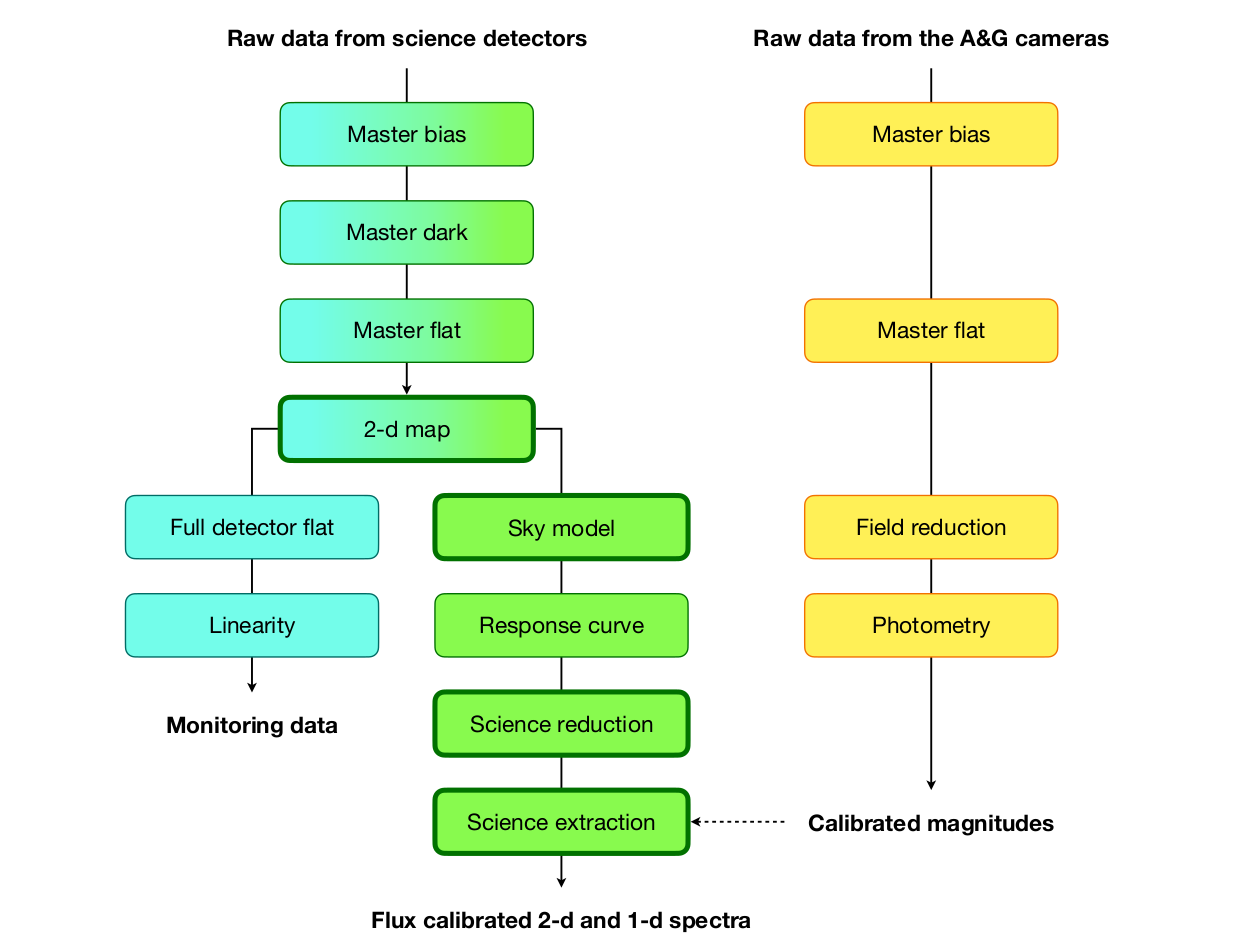
This paper presents a comprehensive overview of the collaborative efforts between the End-to-End (E2E) Simulator and the Data Reduction Software (DRS) team, focusing on the modeling of the U-band efficient Cassegrain spectrograph CUBES (ESO-VLT). The E2E model is a Python-based numerical simulator capable of rendering synthetic raw frames with high precision for both astronomical and calibration sources, starting from their 1-d radiation spectra up to the data produced by the detectors. Data from the E2E are processed by the prototype Data Reduction Software (pDRS), a Python library which implements the critical algorithms of the DRS. The PDRS performs wavelength calibration and extracts a 1-d spectrum from one or more reduced science exposures. The 1-d spectrum produced by the extraction routine is meant to be compared directly with the input spectrum fed to the E2E, actually “closing the loop” allowing for a real end-to-end assessment of the instrument capabilities.
The CUBES consortium includes institutes in Italy (leader), Brazil, Germany, Poland, and the UK. Rodolfo Smiljanic, PI of the SAGA Team, is one of the co-PIs of the CUBES consortium.
CUBES paper at SPIE "Astronomical telescopes and instrumentation"
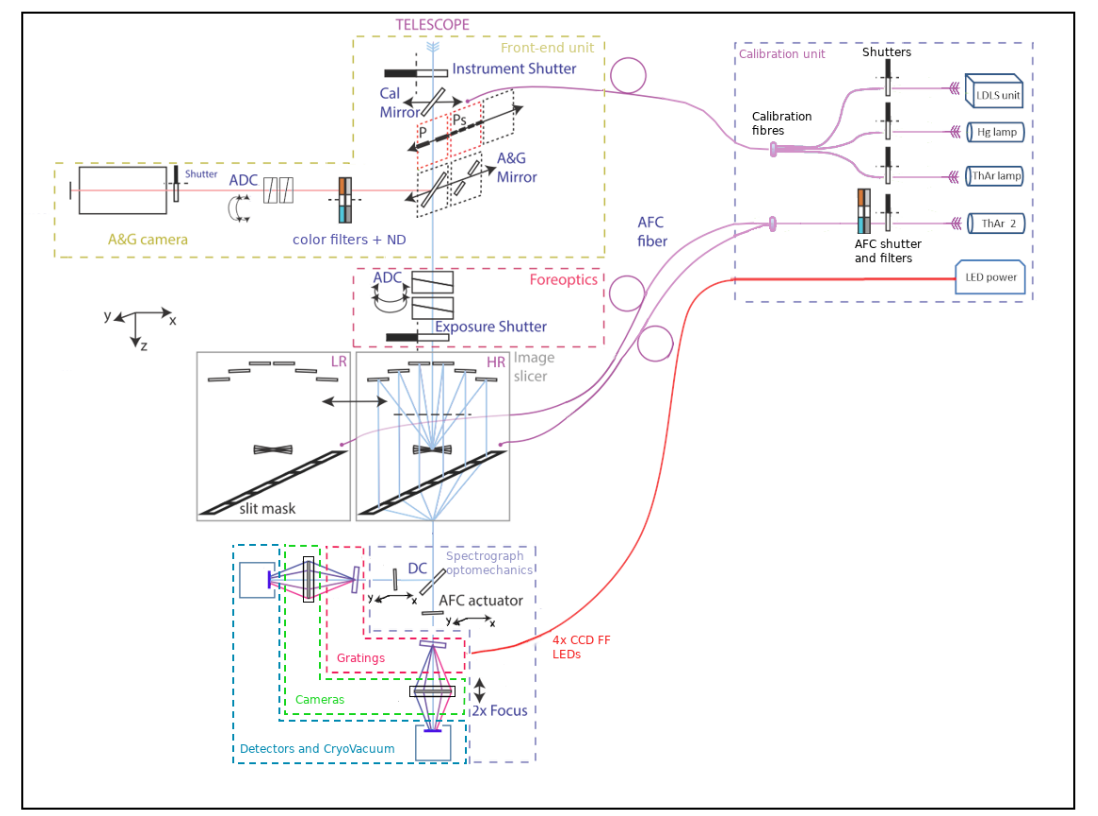
In the era of Extremely Large Telescopes, the current generation of 8-10m facilities are likely to remain competitive at ground-UV wavelengths for the foreseeable future. The Cassegrain U-Band Efficient Spectrograph (CUBES) has been designed to provide high instrumental efficiency ( > 37%) observations in the near UV (300-405 nm). We present the CUBES instrument design, currently in Phase-C and approaching the final design review, summarizing the hardware architecture and interfaces between the different subsystems as well as the relevant technical requirements. We describe the optical, mechanical, electrical design of the different subsystems (from the telescope adapter and support structure, through the main opto-mechanical path, including calibration unit, detector devices and cryostat control, main control electronics), detailing peculiar instrument functions like the Active Flexure Compensation (AFC). Installation at the VLT is planned for 2028/2029 and first science operations in late 2029.
The CUBES consortium includes institutes in Italy (leader), Brazil, Germany, Poland, and the UK. Rodolfo Smiljanic, PI of the SAGA Team, is one of the co-PIs of the CUBES consortium.
End-to-end (E2E) simulator for CUBES
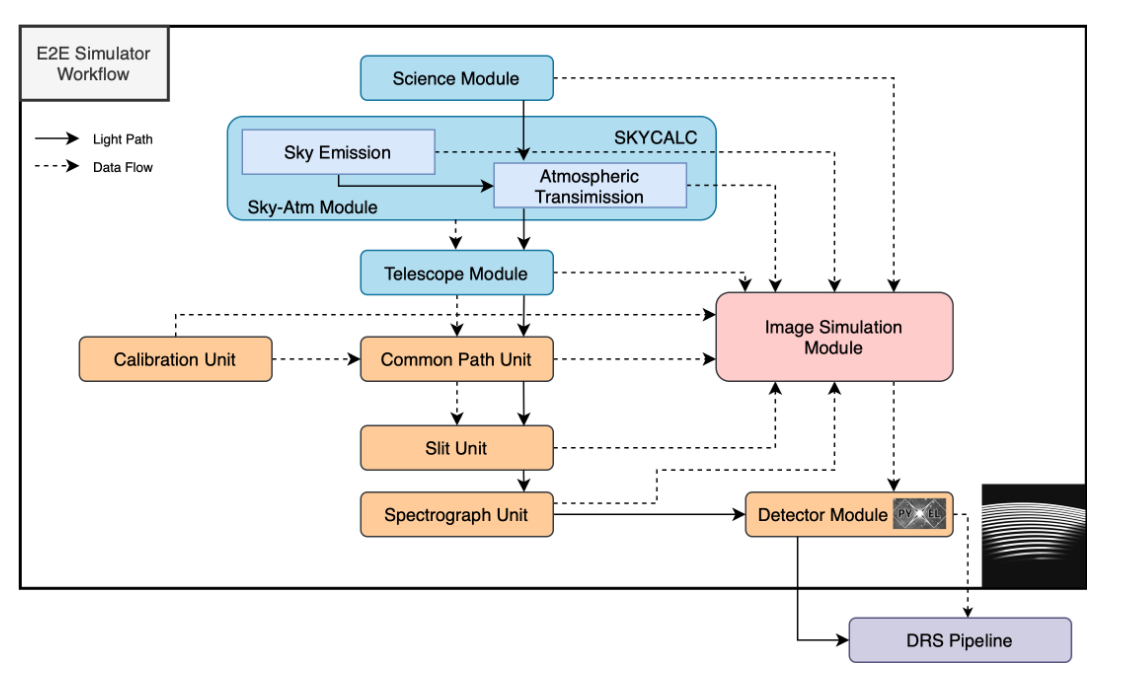
End-to-end models (E2E) aim at simulating the expected astronomical observations starting from the radiation of the scientific sources (or calibration sources) up to the raw-frame data produced by the detectors. This paper describes the E2E architecture, computational models, and tools for rendering the simulated frames for three future spectrographs: SOXS, CUBES and ANDES. Of interest to the SAGA Team is CUBES, the Cassegrain U-Band Efficient Spectrograph, a new instrument being developed to be installed at the 8m VLT of the European Southern Observatory. This spectrograph will cover with a high efficiency the UV ground-based wavelength region (300 - 400 nm). It will have two resolution modes: one of low-resolution with R ~ 5000 and one of high-resolution with R > 20 000.
The CUBES consortium includes institutes in Italy (leader), Brazil, Germany, Poland, and the UK. Rodolfo Smiljanic, PI of the SAGA Team, is one of the co-PIs of the CUBES consortium.
New paper accepted for publication
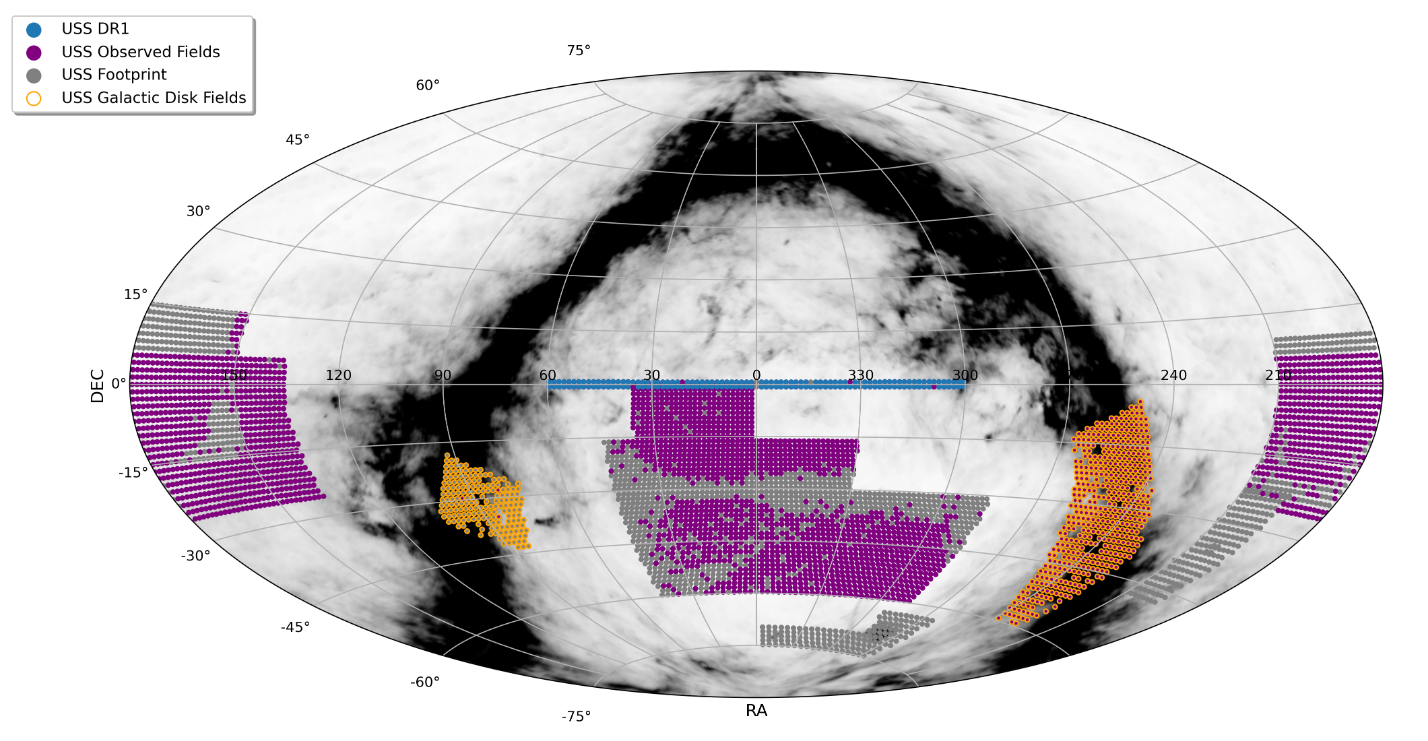
S-PLUS is a photometric survey done in a set of 12 bands (seven narrow and medium-band filters and five broad-band filters) using a 0.826m robotic telescope at the Cerro Tololo Inter-American Observatory (CTIO) in Chile. The data enables a comprehensive characterization of objects by imaging them in different regions of the optical spectra, with the narrow and medium-band filters placed on crucial elemental absorption lines.
The Ultra-Short Survey (USS) is one of many sub-surveys in the S-PLUS project. USS is covering the same area as the overall S-PLUS Main Survey, but with much shorter exposure times. The primary objective of the USS is to identify bright, extremely metal-poor (EMP; [Fe/H] ≤ −3) and ultra metal-poor (UMP; [Fe/H] ≤ −4) stars for further analysis using medium- and high-resolution spectroscopy. This paper presents the first public data release of USS. It contains data for 163 observed fields totalling ∼324 deg2 along the Celestial Equator. By combining colors and magnitudes, 140 candidates for EMP or UMP have been identified for follow-up studies. The USS is an ongoing survey; in the near future, it will provide many more bright metal-poor candidate stars for spectroscopic follow-up.
The paper was lead by Hélio D. Perottoni, a former postdoc at the SAGA Team, and counted with the collaboration of R. Smiljanic, PI of the SAGA Team.
Three-year design study of WST to be funded!
Last March, the WST consortium submitted a grant application for a Horizon Europe call on the topic of "Research infrastructure concept development". The goal was to finance a 3-year conceptual design study for a 12-metre Wide-field Spectroscopic survey Telescope (WST) fully dedicated to multi-object spectroscopy. The funding application has now been approved. It obtained a perfect evaluation score of 15 points out of 15 possible!
WST is currently planned to have a large field-of-view (>2.5 sq. degree). A fibre-fed multi-object spectrograph will be able to obtain, simultaneously, 20,000 spectra in low resolution and 2,000 in high resolution. In addition, a giant 3x3 arcmin integral field spectrograph (IFS) will be at the centre of the field and will be able to patrol an area of 9x9 arcmin. When operating, WST will target 250 million galaxies, 25 million stars at low spectral resolution, and 2 million stars at high resolution in a time frame of 5 years. At the same time, the IFS may obtain 4 billion spectra.
SAGA Team members are involved in the WST Science Team and R. Smiljanic is co-leading the working group responsible for the exoplanet, stellar, and Galactic science case. With the grant, the SAGA Team will be able to fund 18 months of a postdoc position. Together with the WST Science Team, we will help expand and consolidate the Galactic science case that will be addressed by WST.
New Gaia-ESO paper accepted for publication
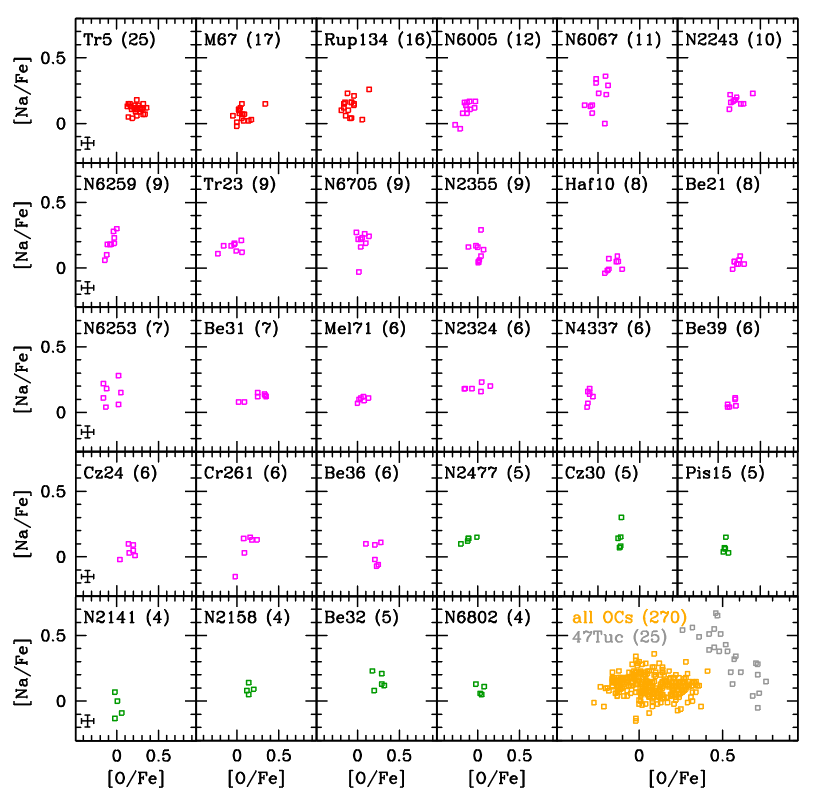
The light element (anti-)correlations shown by globular clusters (GCs) are the main spectroscopic signature of multiple stellar populations. These internal abundance variations provide us with fundamental constraints on the formation mechanism of stellar clusters. Using Gaia-ESO, the largest and most homogeneous survey of open clusters (OCs), this paper checks whether these stellar aggregates display the same patterns. Based on previous studies of many GCs, several young and massive clusters in the Magellanic Clouds, as well as a few OCs, we do not expect to find any anti-correlation, given the low mass of Milky Way OCs. It was found that the distribution of Na abundances is compatible with a single-value population, within the errors. The few apparent exceptions can be explained by differences in the evolutionary phase (main sequence and giant post first dredge-up episode) or by difficulties in analysing low gravity giants. We did not find any indication of an Na-O anti-correlation in any of the clusters for which O has been derived.
The paper was lead by Angela Bragaglia, INAF-Osservatorio di Astrofisica e Scienza dello Spazio di Bologna, Italy, and counted with the collaboration of R. Smiljanic, PI of the SAGA Team.





